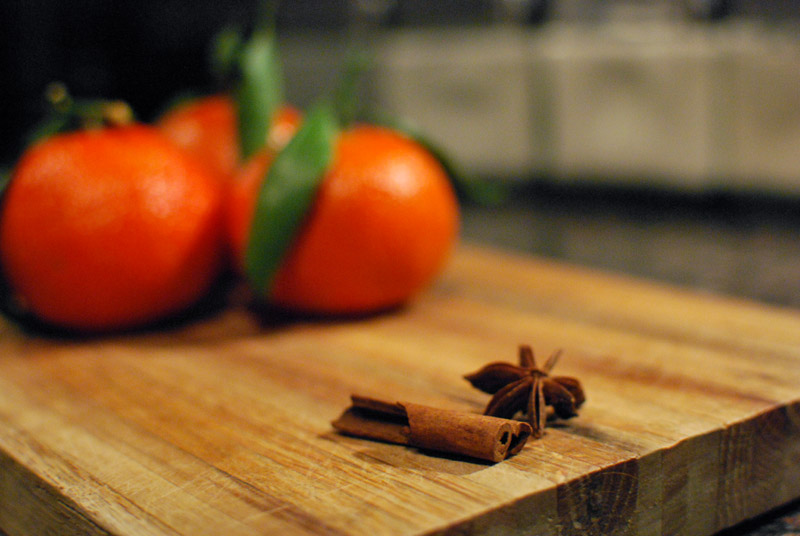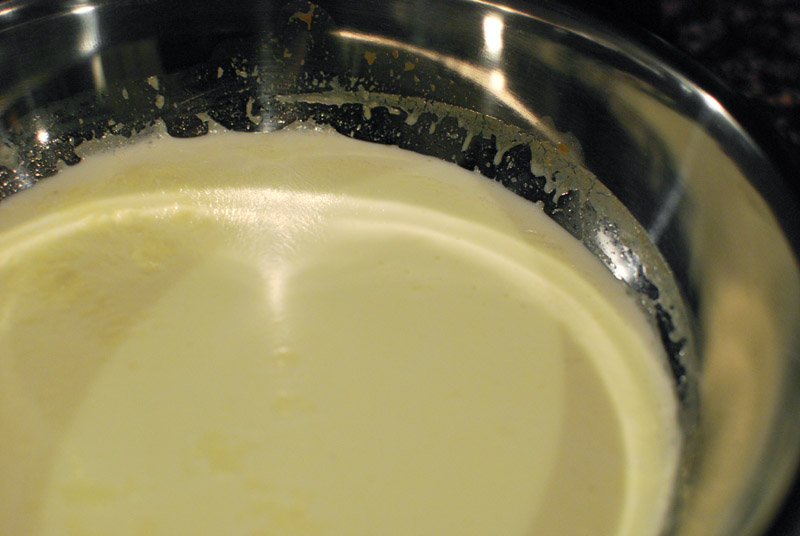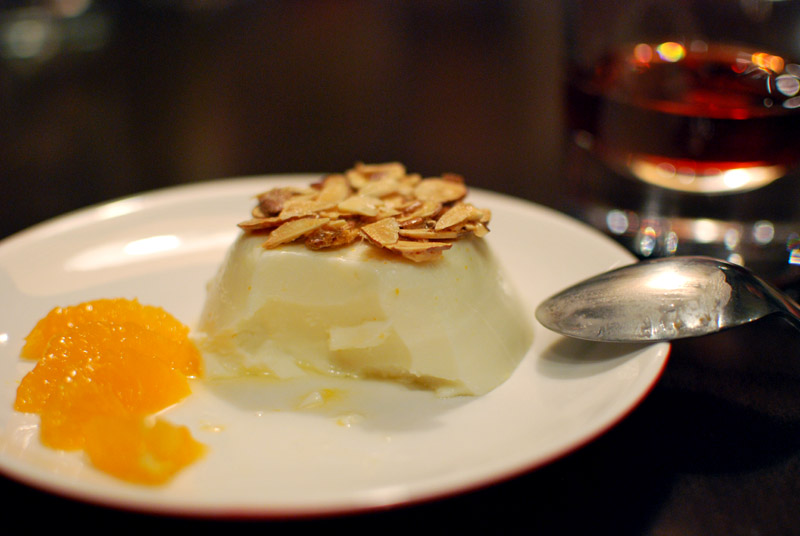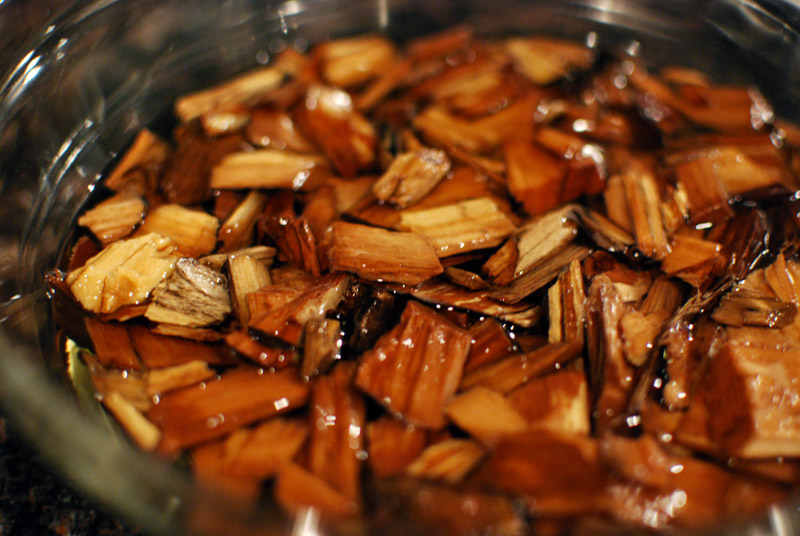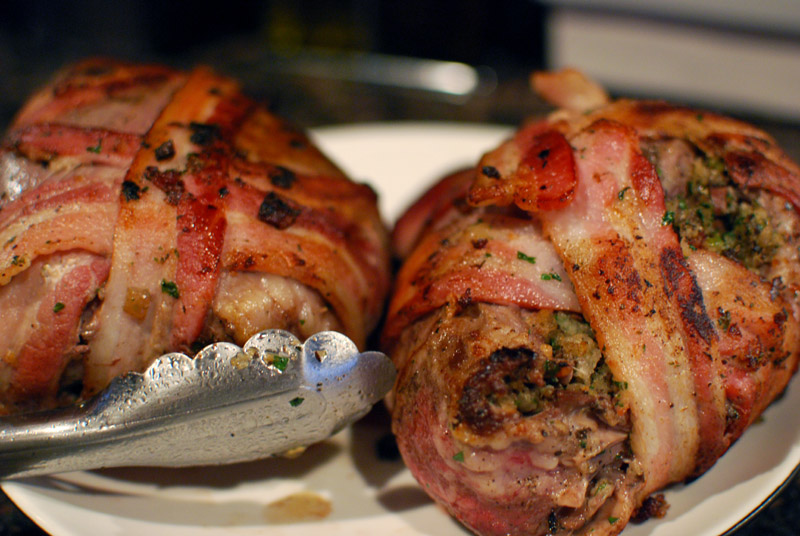
I know it’s come and gone, but I didn’t forget about Valentine’s Day; I just haven’t gotten my thoughts together about this before now. I hope you will forgive me.
Let’s say, for the sake of hypothesis, that you’re a culinary school graduate. Let’s also say that you have a perfectionist streak about a mile wide, and a moderately overachieving nature that infuses you with the urge to constantly trump your own culinary efforts. Lastly, let’s say you’re unemployed. With aaaaaaall the time in the world.
With that framework in mind – all purely hypothetical, of course – you might better understand the dinner that I presented to my sweetheart this last Valentine’s Day. Yes, I’m fully aware that normal people do not cook like this. Ahem.
The inspiration for the whole menu began with a most unusual ice cream recipe. If there’s one word for the type of food that can win over my sweetheart, it’s “unusual”. That, combined with his love of desserts and sweets in general, meant that when I saw a recipe for a pretty gray (yes, gray!) ice cream made with soft European licorice candy, I had to serve it.
I find unusual ice creams, like this one, are a bit… well, strange if served alone, even boring. But pair that anise-scented licorice ice cream with cumin, lemon, clove, cardamom, and ginger, and now you’ve got something interesting going on.
Armed with those flavors and little else, I solicited drink pairing recommendations from my new favorite spirits boutique. The immediate and unhesitant suggestion – a rare and spiced Italian beer – may have scared some off, but I knew my ale-loving sweetheart would surely appreciate it, especially if it paired as well as the shopkeeper insinuated it would. The large bottle (750 mL) meant that this beer would have to pair with the entrée as well, if either of us wanted to be at all useful the next day.
The amber ale, flavored with “anise, pepper, tandori [sic], and curry”, dictated an Indian-spiced dish, and a modest request for seafood narrowed my focus to a manageable level. From there, an appetizer with softer flavors suggested itself; paired with an appropriate cocktail, I had the menu set.
The evening started off gently, with the subtlety of amberjack sashimi lightly dressed with a mignonette-inspired mélange of red grapefruit, cucumber, shallot, and rosé Champagne vinegar. Fried garlic and ginger (giving a nod to the pickled ginger typically served with sushi) provided a contrasting crunch, and were used sparingly enough to not overwhelm the other delicate flavors.

This immodest dish of blushing pink and naked flesh was served with a cocktail that recalled the flavors on the plate, mixing red grapefruit juice with cucumber-infused Hendrick’s gin. Rose water and lime lent a Persian air, beckoning the palate to follow along to the exotic flavors of the entrée. The drink was well-balanced, tending towards sweet, a refreshing counterpoint to the sharp acidity of the topping on the supple fish.
Spices colored the second course, both figuratively and literally. Turmeric and cayenne tinted the ivory of a thick piece of cod with a golden hue, while hints of cumin and black pepper warmed the blood and chased away any chill that crept in from outside the windows. This sunny gem was decorously wrapped with a layer of grape leaves, in modest contrast to the first course. Peeling back the leaves, crisped in the heat of an oven, the provocative scents wafted up as the fish was undressed. A thick raita brought mustard seed, garlic, and lemon along with the creamy tang of yogurt.

On the side, minted smashed peas added a cheeky reference to Britain’s tangled history with India, while brightening the plate with a vibrant green color and flavor. Shaved fennel, lightly tossed with olive oil and lemon juice, gave sharpness and crunch, and offered faint suggestion of the dessert course to follow.
The pièce de résistance, a licorice ice cream parfait, was simple in concept: a tuile cylinder surrounding scoops of ice cream, interlaced with a caramel syrup and toasted nuts. But of course, the flavors weren’t so simple. The ice cream was flavored generously with the aforementioned licorice candy and with Herbsaint (an anise-flavored liquor), while the tuile crunched with lemon zest and the smoke of cumin. The caramel syrup was heady with cardamom, clove, ginger, and pepper; and the earthy almonds and walnuts were coated with bright allspice and a touch of cayenne.
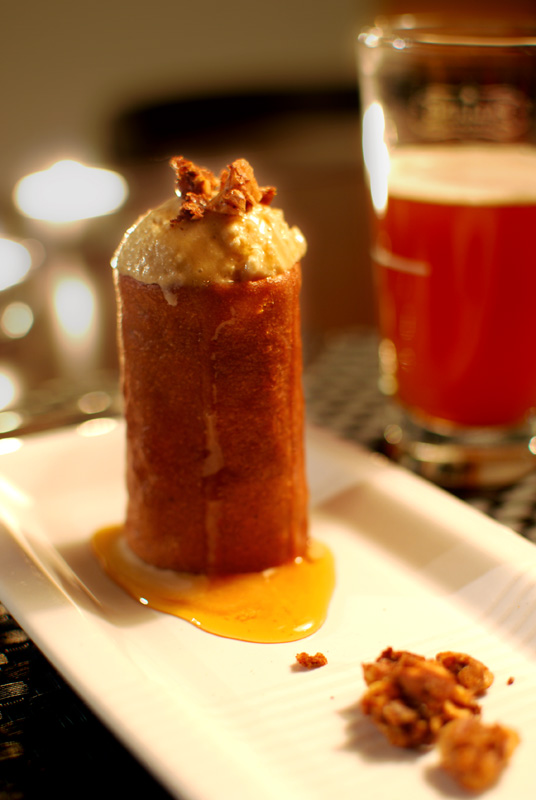
Seemingly so disparate and disjointed, the spices of each different component blended into a seductive unity, each bite drawing a new scent, and a new taste, from the beer. In response, the beer seemed to highlight each spice in the soft ice cream, in the snap of the tuile, in the sleek caramel. The pairing was spot-on, and there’s no wine or cocktail that could possibly have been any better.
Valentine’s Day has at its heart a very sweet sentiment, despite the rampant commercialization that cheapens it: it’s a day to pay extra attention to your special Valentine. Personally, I relish any opportunity to cook a special occasion dinner; so I take what I like from Valentine’s Day, and leave the saccharine store-bought sentiments behind. There is no greater romance to me than a well-planned and well-executed meal, even more so if it’s specifically tailored to particular tastes.
This meal was a gift both from and to myself. I dreamed it up and cooked it, true; but I also got to eat and enjoy it as well. As much work as such a dinner entails, I find every minute is more than worth it when, at the end of the day, you look across a candle-lit table to see eyes that taste what you taste, and drink what you drink, and you both find it to be breathtakingly good.
***********
MENU
Amberjack sashimi, red grapefruit and cucumber “mignonette”
Cardamom Rose cocktail
Indian-spiced cod wrapped in grape leaves with raita, minted smashed peas, shaved fennel
Shangrila, Birra Troll
Licorice ice cream parfait, cumin tuile, spiced clear caramel syrup, spiced almonds and walnuts
Shangrila, Birra Troll
***********

Amberjack Sashimi With Red Grapefruit and Cucumber “Mignonette”
Serves 2
The bracing topping on this fish was inspired by a traditional mignonette, a vinegar and pepper sauce typically used on raw oysters. For the vinegar, I used a bottle of rosé Champagne that had gone off, but was too good to throw out; store-bought vinegar will do just as well. You can substitute any mild and firm white fish for the amberjack, depending on what’s fresh at your fishmonger.
Ingredients:
- 1/2 red grapefruit, cut into supremes, and diced
- 1/2 cucumber, peeled and seeded, cut into 1/4 inch cubes
- 1 medium shallot, minced
- 1/2 teaspoon whole white peppercorns, crushed coarsely
- 1/4 cup Champagne vinegar, rosé if possible
- Kosher salt, to taste
- 1/3 cup olive oil, more or less, for frying
- 1 small knob fresh ginger, about 1 x 2 inches in size, peeled and cut into matchsticks
- 1 large clove garlic, peeled and cut into matchsticks
- 6 to 8 sprigs parsley, leaves only
- 4 to 6 ounces amberjack, sliced thinly
Directions:
- 1. In a medium bowl, combine the grapefruit, cucumber, shallot, peppercorns, and Champagne vinegar. Add a pinch of salt, to taste. Cover and refrigerate for at least 30 minutes, or up to several hours.
- 2. Heat the olive oil over medium heat in a small pan until hot but not smoking. Fry the ginger until browned and crisp, about 1 minute. Remove to a paper towel to drain. Fry the garlic in the same oil until browned and crisp, about 30 seconds. Remove to a paper towel to drain. Fry the parsley in the same oil until crisp, about 10 seconds. Remove to a paper towel to drain.
- 3. To serve, arrange the amberjack slices on a plate. Top with the grapefruit-cucumber mixture. Garnish with the fried ginger, garlic, and parsley. Serve immediately, before the acidic dressing begins to “cook” the raw fish.
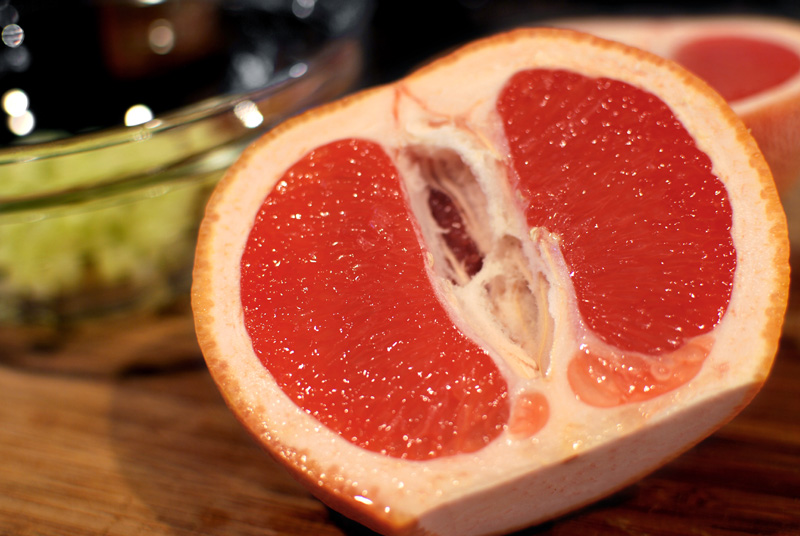
Cardamom Rose Cocktail
Adapted from Apothecary, via Design Sponge
Makes 2 cocktails
You can find rose water at some specialty liquor stores, spice stores, or at Middle Eastern or Indian groceries. The syrup recipe makes more than you need for one batch, so you can re-create the cocktail several times. You will want to do this.
Ingredients for the rose syrup:
- 1 lime, juiced (about 2 tablespoons juice), peel reserved
- 1 1/4 cups water
- 1 1/2 cups sugar
- 1/4 cup rose water
- 3 cardamom pods, crushed
Ingredients for the cocktail:
- 2 cardamom pods
- 3 ounces Hendrick’s gin
- 1 1/2 ounces rose syrup
- 1 ounce fresh lemon juice
- 1 ounce fresh red grapefruit juice
- 4 dashes bitters
- 2 long strips of grapefruit peel, for garnish
Directions:
- 1. To make the rose syrup, combine all ingredients in a small saucepan, including the lime peel. Heat, stirring, until sugar dissolves. Remove from the heat, and let stand, covered, at least 30 minutes. Strain. Store in the refrigerator until ready to use.
- 2. To make the cocktail, very lightly muddle (crush) the cardamom pods at the bottom of a shaker. Add the remaining ingredients, and add ice. Cover and shake hard. Strain into two glasses. Garnish with the grapefruit peel.

Indian-Spiced Cod Wrapped in Grape Leaves With Raita
Adapted from Megan Moore and David Tanis
Serves 2
Feel free to substitute the cod for whatever similarly thick and mild fish is fresh at your fishmonger. For the raita, if you can’t find the thick Greek-style yogurt, simply drain 1 cup plain yogurt in a paper-towel-lined sieve over a bowl in the refrigerator for about 6 to 8 hours.
Ingredients for the spice rub:
- 2 teaspoons cumin seeds
- 2 teaspoons coriander seeds
- 2 teaspoons fennel seeds
- 1 teaspoon whole black peppercorns
- 1 tablespoon ground turmeric
- 1/2 teaspoon cayenne pepper
- 1/4 teaspoon ground cloves
Ingredients for the fish:
- 8 to 10 large brined grape leaves, rinsed, patted dry, and stems trimmed
- 2 thick cod fillets or steaks, about 6 ounces each, and about 1 inch thick
- 2 tablespoons olive oil, divided
- Salt, to taste
Ingredients for the raita:
- 1 teaspoon olive oil
- 1/2 teaspoon mustard seed
- 1/2 teaspoon cumin seed
- 1 garlic clove, minced
- 1/2 teaspoon minced or grated fresh ginger
- 1/2 small serrano chile, finely minced
- 1/2 cup plain Greek-style yogurt
Directions:
- 1. To make the spice rub, heat the cumin, coriander, fennel, and peppercorns in a dry pan over medium heat until fragrant, 2 to 3 minutes. Transfer to a spice grinder or mortar, and grind finely. Blend with the turmeric, cayenne, and cloves.
- 2. To make the fish, preheat the oven to 400º F, and line a baking sheet with aluminum foil. Lay half the grape leaves out on a work surface, vein-side up, overlapping the leaves to make a solid sheet. Repeat with remaining leaves.
- 3. Drizzle the fish evenly with 1 tablespoon of the olive oil, and sprinkle each fillet with 1 to 2 teaspoons of the spice rub. Sprinkle with salt. Rub the spices onto the fish, until entirely coated.

- 4. Place each piece of fish on top of one of the rounds of grape leaves. Wrap the leaves around the fish, and transfer seam-side down to the prepared baking sheet. Drizzle the packets with the remaining olive oil, and gently rub to coat evenly.

- 5. Roast the fish at 400º F for about 20 minutes, or until the grape leaves have crisped and the fish is just cooked through. (If your fish is thinner than 1 inch, it will take less time to cook.)
- 6. While the fish cooks, make the raita. Heat the olive oil in a small frying pan over medium heat. Add the mustard and cumin seeds. When the seeds just begin to pop, add the garlic. Cook for about 10 seconds, not long enough to let the garlic turn brown. Add all the contents of the pan to the yogurt, and stir in the ginger and serrano. Stir to combine, and add a pinch of salt to taste.
- 7. The cooked fish will stand at room temperature for up to 1 hour. When ready to serve, you can either unwrap the fish and top with the raita, or let dinner guests unwrap their own piece, passing the raita at the table.
Minted Smashed Peas
Adapted from Jamie Oliver
Makes 3 or 4 servings
Ingredients:
- 1 tablespoon olive oil
- 1 large or 2 medium shallots, minced
- 1 handful mint, chopped roughly (about 2 tablespoons)
- 8 ounces frozen peas
- 1 pat butter (1 to 2 teaspoons)
- Salt and pepper, to taste
Directions:
- 1. Heat the olive oil over medium-high heat in a medium-sized saucepan. Add the shallot and cook until soft and fragrant, about 3 minutes. Add the mint and peas, and cover. Let steam for 2 to 3 minutes, or until just cooked. Uncover, add the butter, and salt and pepper to taste. Smash with a potato masher, or by smashing against the side of the pan with the back of a spoon. Adjust seasonings if needed, and serve warm.
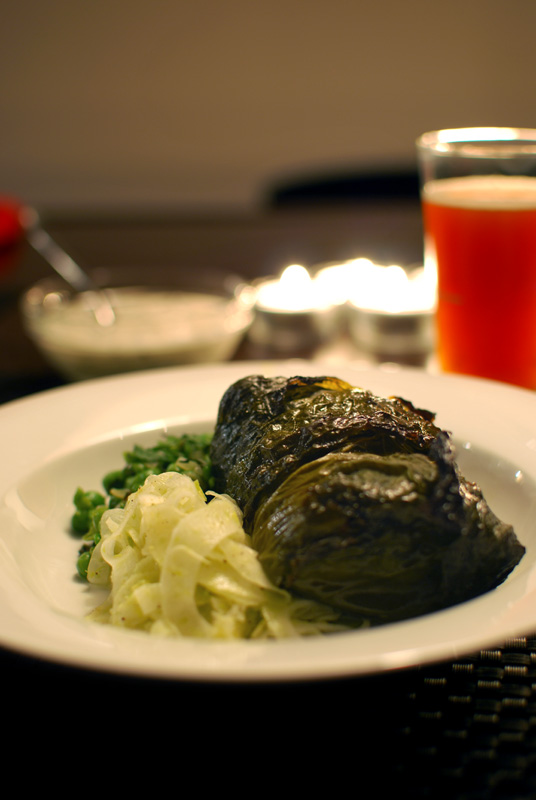
Shaved Fennel
Makes 2 servings
Ingredients:
- 1/2 bulb fennel
- 1/2 lemon, juiced and zested
- 2 teaspoons olive oil
- Salt and pepper, to taste
Directions:
- 1. Using a mandoline or sharp knife, shave the fennel across the grain into paper-thin slices. Toss with the juice and zest of the lemon half, the olive oil, and salt and pepper.
Licorice Ice Cream Parfait
Inspired by the Praline Parfait served at Commander’s Palace in New Orleans
The following recipes make more than enough for two servings of dessert; but depending on how large the portions are, the serving size can vary widely.
Ingredients:
- Cumin tuile cylinders (recipe below)
- Licorice ice cream (recipe below)
- Spiced clear caramel syrup (recipe below)
- Spiced nuts (recipe below)
Directions:
- 1. Place one tuile cylinder on a plate. Fill with one scoop of licorice ice cream, and top with about 2 teaspoons caramel syrup, and a few spiced nuts. Continue adding ice cream, syrup, and nuts, until the cylinder cannot hold any more. Serve immediately.
Cumin Tuile Cookies
Adapted from The Professional Pastry Chef, by Bo Friberg
Makes about 3/4 cup batter
It is very important to have all ingredients at room temperature with this recipe. If cold, the butter will not cream properly, and cold egg whites will make the butter clump into tiny flakes; both of these outcomes will poorly affect the batter. If all ingredients are at room temperature, this batter is quite easy to make. I recommend using a silicon baking mat (such as a Silpat) to bake these, which eliminates any issues of the cookies sticking, and holds warmth so that the cookies remain pliable for the longest amount of time. If that’s not available, use baking sheets that have been well greased and floured. Additionally, you can shape these cookies without using a template, but a template cut from a sheet of plastic (available at art supply stores) will produce cookies of the most even thickness, which will bake most evenly. I’ve used mat board here, but don’t really recommend it, as I found it a bit too thick, and entirely incapable of being re-used.
Ingredients:
- 1/4 teaspoon whole cumin seed
- 2 ounces (4 tablespoons) unsalted butter, at room temperature
- 2 ounces (1/2 cup, or 56 grams) powdered sugar, sifted
- 1/4 cup egg whites (from 2 large eggs), at room temperature
- 1/4 teaspoon vanilla extract
- 2 ounces (about 1/2 cup) unbleached all-purpose or cake flour
- Zest of 1 small lemon
Directions:
- 1. In a dry pan, toast the cumin over medium heat until fragrant, about 2 minutes. Transfer to a spice grinder or mortar, and grind finely.
- 2. In the bowl of a stand mixer, using the paddle attachment, cream together the butter and powdered sugar at medium to medium-high speed until fluffy, about 2 minutes. Scrape the bowl as needed. Add the egg whites and vanilla, and beat until incorporated.
- 3. Add the flour, lemon zest, and ground toasted cumin. Mix on low speed until just incorporated; do not overmix.
- 4. Store batter, covered, in the refrigerator. Batter will keep for several weeks. Allow to soften slightly after removing it from the refrigerator, then stir until smooth and spreadable before using. Do not let get too warm, as the edges of the tuile will be ragged if the batter is too soft.
- 5. Preheat oven to 400º F, and line a baking sheet with a silicon mat (such as a Silpat). Using an offset spatula, thinly spread the batter flat and even within a template (directions below), on the mat. Carefully lift the template off, taking care not to disturb the shaped batter.
- 6. Bake the tuile at 400º F until the cookies are evenly and well browned, 5 to 8 minutes. Keep a close eye on them, as they can burn in a moment.
- 7. Leave the pan in the oven, with the door open. Using an offset spatula, remove one cookie at a time, and curl around a small drinking glass (or any other similarly small cylinder), shaping it into a cylinder. This must be done fairly quickly, before the cookies start to cool and become brittle. Repeat with remaining cookies on sheet. If the cookies harden too soon, return to the oven for a moment until pliable again. Let cool. Store in an airtight container at room temperature for up to 3 days.
Note: The template I used was made of mat board, but I suggest a slightly thinner sheet of plastic, which may be rinsed and re-used. Cut out a rectangle about 4 x 8 inches, which will roll up into a cylinder about 4 inches tall and 2 1/2 inches in diameter. I found this a perfect size cylinder to hold the portion of ice cream I wanted to serve. If you like, you can also make tuile bowls, by using a circle template, and shaping the cookies by placing in a bowl while still warm, or draping over the underside of a muffin tin.
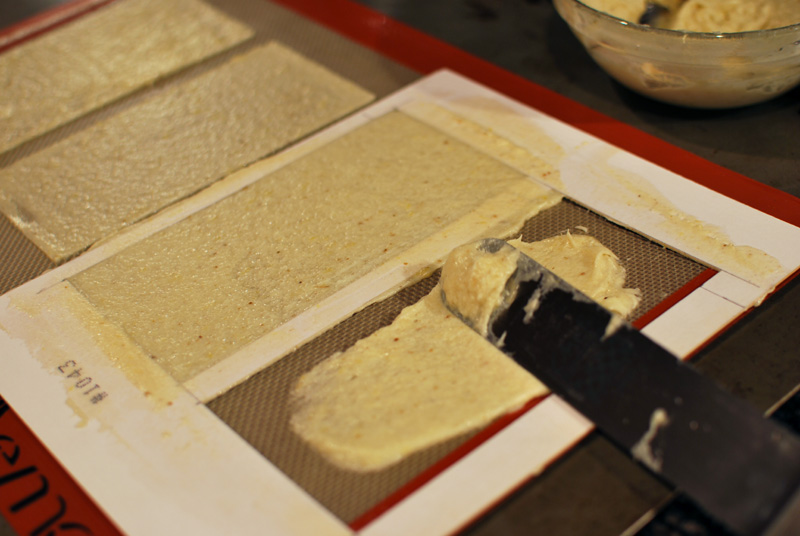
Licorice Ice Cream
Adapted from Bake My Day and Aliza Green
Makes about 1 quart
Though my version didn’t turn out as beautifully and purely gray as Bake My Day’s version (the result of including egg yolks for a more traditional ice cream base), it was still a very lovely tan. The Herbsaint liqueur keeps the finished ice cream very soft, even after sitting in the freezer for some time.
Ingredients:
- 6 egg yolks
- 1/2 cup plus 2 tablespoons sugar
- 1 three-fingered pinch salt
- 1 3/4 cup milk
- 1 cup heavy cream
- 30 one-inch soft European-style licorice candies (such as Panda), or about 2 1/2 ounces
- 2 tablespoons Herbsaint, or other anise-flavored liqueur
- 2 teaspoons vanilla extract
Directions:
- 1. Whisk the egg yolks and the sugar together in a large bowl.
- 2. In a nonreactive saucepan, heat the salt, milk, cream, and licorice candy over medium heat, stirring frequently until the candy melts. (There may still be small clumps of licorice; these will get strained out later.) Remove from the heat.
- 3. Add a spoonful or two of the hot milk mixture to the egg yolks, whisking constantly. Gradually temper in more spoonfuls of the hot milk, continuing to whisk to prevent the eggs from cooking. When about half of the milk has been added, you may combine the rest of the two mixtures together. Return to the pan.
- 4. Over medium heat, and stirring gently but constantly, cook the mixture until it reaches 165º F on an instant-read thermometer. Immediately remove from the heat, and strain the mixture through a fine mesh strainer into a medium bowl. If possible, set this bowl in an ice bath to cool rapidly; otherwise, let cool at room temperature. Stir in the Herbsaint and vanilla. When cool, cover and refrigerate for at least 8 hours and up to 2 days. Freeze in an ice cream maker, according to manufacturer’s instructions.
Spiced Clear Caramel Syrup
Makes about 1 cup
As tempting as it is to use flavorful brown sugar here, resist the urge to do so. For caramel, it is necessary to use granulated sugar, which has very few impurities. Brown sugar will simply crystallize into a nasty lump.
Ingredients:
- 8 ounces granulated sugar
- 1/4 teaspoon fresh lemon juice
- 6 tablespoons room-temperature water, divided
- 1 stick cinnamon
- 1 star anise
- 5 cardamom pods
- 20 whole cloves
- 1/2 teaspoon black peppercorns, coarsely crushed
- 1/2 teaspoon fennel seed
- A block of fresh ginger, about 1/2 x 1 x 1 inches in size
Directions:
- 1. In a small saucepan, heat the sugar, lemon juice, and 1 tablespoon water over medium heat, stirring just until the sugar has melted. Immediately refrain from stirring further, though you may swirl the pan to heat evenly as needed (this will prevent unwanted crystallization). Cook until the caramel has turned an amber color, about 5 minutes. Do not leave unattended, as the caramel will change color and burn very quickly.
- 2. Slowly add the remaining water, being very careful, as the caramel will bubble up furiously. Heat, stirring, until all the caramel is dissolved. Add the remaining ingredients, cover, and let stand for at least 1 hour and up to 1 day.
- 3. Strain out the spices, and thin with additional water if needed. Syrup will keep indefinitely in the refrigerator.
Spiced Nuts
Makes 1 cup
Ingredients:
- 1 tablespoon egg white
- 1/2 teaspoon water
- 1 tablespoon brown sugar
- 1 pinch each: salt, ground allspice, cayenne pepper, ground ginger, ground cloves, and ground cinnamon
- 1/2 cup (about 2 ounces) chopped almonds
- 1/2 cup (about 2 ounces) chopped walnuts
Directions:
- 1. Preheat the oven to 250º F. In a bowl, beat the egg white with the water until foamy. Whisk in the brown sugar and spices. Add the chopped nuts, and toss to coat.
- 2. Line a baking sheet with aluminum foil. Spread the nuts out in a single layer on the prepared pan. Bake for 45 to 60 minutes, stirring occasionally, until dried out. Let cool. Store at room temperature in an airtight container.
